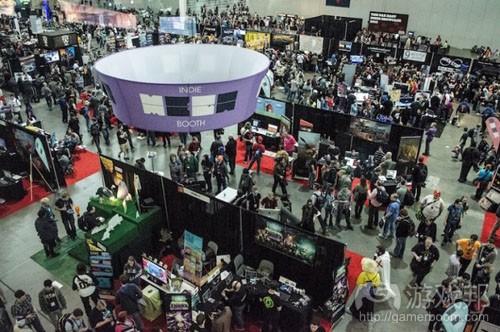独立游戏相互合作才能拥抱未来
作者:Ben Serviss
如今的我们对于独立游戏泡沫充满了绝望,对过度饱和的市场充满了担忧,并且对独立开发者不能再做出任何进步而感到深深的恐惧,似乎我们的前进道路已经被确定好了。可能这些情况正在你的眼皮底下悄悄地发展着。
独立游戏开发的下一个阶段将受到合作的加强。
这一切意味着更多开发者(不再只是默默地工作着)将为了创造,营销并销售游戏而将自己的努力投入其他带有相同目标的人身上。
这种合作已经在像《SPORTSFRIENDS》等游戏上得到了实践,即在一个合作品牌下(让消费者能够更轻松地理解)结合4款独立的单机多人游戏。如果是工作室的话,像Fixer Studios便尝试过这一做法,这是一家吸引了“各种资深志愿者作为不断变化的劳动力”的“合作型工作室”(那些志愿者们愿意将时间和资源投入在自己所致力的游戏中)。
Indie MEGABOOTH的市场营销便是如此,即汇聚一些独立开发者的能力在像PAX和GDC大会上与某些AAA级市场营销预算相竞争。
Humble Bundle以及其它类似的收藏包网站也使用了这种方法,即将可能未被注意到的独立游戏直接带向那些渴望购买优秀游戏的玩家。
“我们四个人大约是在同时间制作游戏,我们也受到了彼此的影响。通过在一个项目上进行合作,我们希望能够创造出某些可能超越任何独立游戏的内容。”—-SPORTSFRIENDS Kickstarter
但将一群人汇聚在一起去完成一个共同的目标与传统的AAA级开发是否一样呢?并不完全相同。这里所存在的区别在于这种类型的独立合作增长了传统工作者/工作室/发行商不再能够满足到的需求。对于独立工作的开发者来说,他们可以通过各种方式去利用作为独立创造者的独特优势。
灵活性。当剩下的AAA级工作室相继裁员后,更多这些失去工作的开发者便会选择离开产业或走向独立开发之路。当独立开发者暂时或永久组合在一起去完成一个共同的目标时,AAA级产业不断用于说服员工的谎言(即他们的工作是基于整个公司,而不是某一特定项目)将最终被拆穿。
在失去工作后不需要再迁移至某个国家,能够具有更高的自主权而独立工作,开发者还可以根据自身的需求在不同项目上与其他人合作,即使项目未取得成功,任何参与者的生活也不会遭到彻底的打击,并且他们在产业中的“稳定工作”也不会发生彻底的改变。
网络效应。当独立开发者与其他人合作去承担一个项目时,这便创造了另一种有形效益:增加个人网站的访问量。这是用于从来源中获取所有内容并通过合作而推动游戏和事件的发展。
举个例子来说吧,当我的公司Studio Mercato有机会能够与一个单机多人游戏主题活动(游戏邦注:突出我们为自己的游戏《Crystal Brawl》所创造的街机)合作时,我们不仅能够利用每个团队成员个人网站进行宣传,同时还能利用开发团队去呈现其它三款游戏。
“从个体来看,我们都很小。但是汇聚在一起的话,我们就非常强大。当然了,让独立开发者获得关注可能很困难,但是我们已经汇聚了所有的资源去获得一个巨大的优势并将其用于我们的创造性游戏中。如今我们的资源比一家大型工作室还大!”—-Indie MEGABOOTH Facebook Page
当然了,这与AAA级开发也存在一些共性,但主要还是一些差别。
AAA级开发经常包含一些必须相互协作的连锁块,就像通过一个单一愿景创建一座金字塔。独立合作是较为宽松的实体,虽然也需要相互协作,但是能够更开放地进行解释,并且是一种非传统的解决方法—-就像作为一个群组构想并绘制一副壁画。这里的区别在于自主性和授权,不只是基于创造性角度来看,还涉及到工作室以外的生活。
随着剩下的一些大型工作室继续收缩着,更多独立工作中将获得自由,独立开发者将花更多时间去学习如何进行独立经营。
他们可能会犯错,会吸取经验教训,也会与独立开发的现实产生矛盾。但最终他们中会找到真正的自己。
然后他们便会发现彼此。
(本文为游戏邦/gamerboom.com编译,拒绝任何不保留版权的转载,如需转载请联系:游戏邦)
Together We Are Mega: The Collaborative Future of Indie Game Development
by Ben Serviss
For all the hand-wringing about the indie games bubble, concerns of an over-saturated marketplace, and fears that soon it will be impossible to make any kind of headway as an indie developer, the path forward has already been charted. It may have sneaked right by, under your nose. It will seem obvious, perhaps insultingly so.
The next phase of indie game development will be powered by collaboration.
All this means is that more developers, instead of toiling in seclusion, will join their efforts with others with similar goals in order to make, market, and sell games.
It’s already happening in development with compilations like SPORTSFRIENDS, combining four separate niche local multiplayer games together under one collective branding that’s easier to understand from a consumer point of view. On the studio level, it’s happening with experiments like Fixer Studios, a “collaborative cloud studio” that draws from a “constantly fluctuating workforce of veteran volunteers” who pool their time and resources to work on games as needed.
It’s already happening in marketing with the Indie MEGABOOTH, harnessing the shared power of dozens of indie game developers to compete with triple-A marketing budgets at convention floors at shows like PAX and GDC.
It’s already happening in sales with Humble Bundle and similar bundle sites, bringing indie games that may have gone unnoticed directly to attentive gamers eager for a deal on great games.
“The four of us made our games around the same time, and we’ve all influenced each other. By collaborating on one project, we hope to make something that transcends any of the individual games.” –SPORTSFRIENDS Kickstarter
But bringing a bunch of people together to accomplish a common goal – isn’t that the same thing as traditional triple-A development? Not exactly. The difference here is that independent collaboration of this type has grown out of needs that are no longer able to be met by the traditional worker/studio/publisher system. And for developers operating independently, there are ways to take advantage of the unique benefits being an indie offers.
Flexibility. As each remaining triple-A studio sheds workers or shutters completely, more and more of those jobless developers either leave the industry or go indie. As indies band together in temporary or permanent fashion to accomplish mutual goals, the lie that the triple-A industry sells to its workers over and over again – that their jobs are with the company, instead of on a given project – finally ends.
Relieved from the stresses of having to relocate across the country (or the globe) if they’re let go, and able to function with a higher level of autonomy that working independently enables, devs can join forces with other entities at will, per-project, with no party’s life being completely upended if the project doesn’t work out and their “stable job” in the industry ends up being precisely the opposite.
Network effect. As indies collaborate with others to undertake projects, it creates another tangible benefit: increased access to personal networks. This comes in handy for just about everything from sourcing leads on contract work to promoting titles and events.
For example, when my company Studio Mercato was presented with the opportunity to co-host a local multiplayer game-themed event featuring the arcade machine we built for our game Crystal Brawl, we were able to leverage not only each team member’s personal network to get the word out, but the development teams for the three other games presenting.
“Individually, we’re tiny. Together, we are mega. Sure, it may be tough for indies to get noticed, but we’ve pooled our resources to get a huge booth, front and center at the show, to showcase all our awesomely creative games. Our booth is now bigger than a big studio booth!”
–Indie MEGABOOTH Facebook Page
Of course, there are parallels to triple-A development – groups of people working together toward a common goal – but there are key differences.
Triple-A development is often composed of interlocking pieces that must function together just so, like building a pyramid from a singular vision. Indie collaborations are looser entities that, while also needing to function together, are more open to interpretation and unconventional solutions in the spirit of empowered discovery – like conceiving and painting a mural as a group. The difference is autonomy and empowerment, not only in creative vision, but in life outside of the studio.
And it’s happening right now. As the remaining big studios continue to contract, spilling out more independent workers into the wild, the indie developers of tomorrow will take the time to learn how to operate on their own.
They will make mistakes, learn lessons, and come to grips with the realities of indie development. Eventually, they will find themselves.
Then, they will find each other.(source:gamasutra)









































